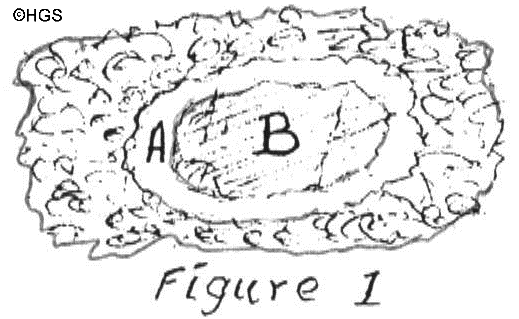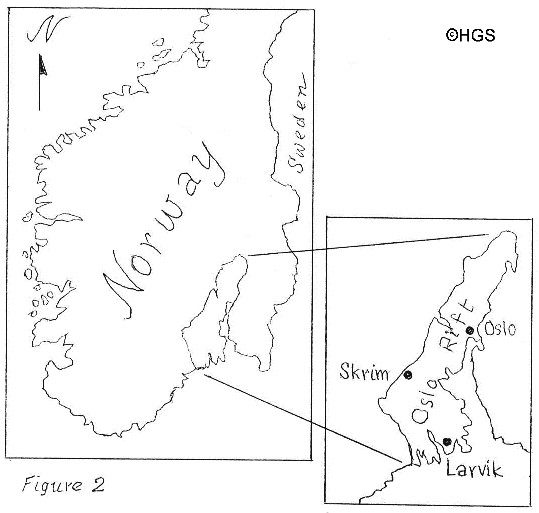|
Humberside Geologist No. 12
Two very interesting and contrasting
coarse-grained plutonic rocks
found on our beaches
By Cyril Dutton
|
Humberside Geologist No. 12
Two very interesting and contrasting
coarse-grained plutonic rocks
found on our beaches
By Cyril Dutton
As you walk along the beaches of Yorkshire you will find a number of erratics.They are pebbles of various sizes which have been transported from other places by ice sheets during the glacial period.
Two very interesting types are Shap granite which is pale pink, and Larvikite which is medium or dark bluish grey. These two have been selected not only because they are both coarse-grained plutonic rocks, but because they are two distinctive rocks which we can be sure of their place of origin with certainty.
The pimple called Shap granite
Shap granite, of course, came from the small outcrop of granite near the Lakeland town of Shap. And larvikite came from the rocks around the Norwegian town of Larvik. Because I am sure you are very familiar with the Shap granite, I will write about this only briefly.
Shap granite is a leueocratic plutonic rock which is often used for decorative purposes and can be found in many cities of the UK. In London, for example, it has been used to make bollards to designate the boundary of St Paul's cathedral. Once you know its characteristics, it is one of very few rocks you can be sure of its source.
The exposure of granite in Cumbria is but a small pimple of rock upon a very large granite mass which extends over a wide area of the Lake District. As you will already know, its formation is related to the closure of the ancient Iapetus Ocean which prior to that event separated Scotland from England.
Caution because of IRA
The last time I visited the quarry on Shap Fell, a security guard prevented me from entering. Presumably because of IRA activity. But on previous occasions 1 was able to enter and inspect the quarry face and its rocks. One piece displayed the distinctive 'rapakive' texture (Figure 1). this name is given to a feldspar phenocryst involving the growth of a plagioclase mantle (A) around an alkali feldspar core (B). Now I will switch to the larvikite rock, named after the town of Larvik (Figure 2), which has a much more complex and interesting history.


We would have enjoyed the experience
But of course, we humans did not exist during the Permian. And one would indeed need a lifespan of some millions of years to be able to observe the entire dramatic sequence.
Perhaps we can try to satisfy ourselves by creating a mental picture of what happened. Firstly, let us consider Norway at the start of the Permian. While most of the rocks along the southern part of Norwav and Sweden are various gneisses of Precambrian age, the rocks of the Oslo rift are exceptions. Long before the volcanism of this region began, the area was covered with sediments of Cambdo-Siluran age. As material had been washed down by the huge rivers draining from the eroding mountains in the north. These mountains were built during the Caledonian orogeny.
The present-day city of Oslo is built on the rocks of the Oslo (Figure 2). But this rift is not like any ordinary rift. It is not like the neat and simple great Rift Valley of East Africa. Within the Oslo zone it was more like a 'basin and range' terrain, and that is why it is often called Oslo Rifts in the plural. It is approximately of the same age as the Midland valley of Scotland, and its volcanic activity is commonly known as being of Permian age. Yet the initial efflusive volcanism began about 295 Ma. That, of course, was about 15 Ma before the Carboniferous/Permian boundary which is dated at 280 Ma.
An Iceland-type experience?
The first lavas to pour out were effusive basalts. This effusive display, like that of Iceland today, would indeed have been a delight to watch. It is well-known that a release of pressure plus the addition of water reduces the temperature at which the mantle rock becomes subject to partial melting. And this, of course, produces basalt This rifting would certainly have provided both of the above requirements.
Next, we may ponder the point where this activity began. It started in the area close by the present-day town of Skrim, which is located along the western edge of the Oslo Rift (Figure 2). This effusive activity introduced the major volcanic phase which lasted for at least 3 Ma. However, some workers believe it lasted as long as 11 Ma.
A 150 m thick pile?
Today geologists have divided the rift into two zones: the southern one is called the Vestfold, where the early basalt pile reached a thickness of 120 m to 150 m; The northern zone is called the Krokskogen plateau where the lava pile was between 20 to 30 m thick and here the rocks consisted of tholeiitic basalts. And naturally, with time, the basalts of the Vestfold gradually up-graded into alkali basalts.
How it evolved
Followmg the alkali basalts, the lavas evolved into rhomb porphyry flows and these covered the entire plateau of the Oslo rifts. Plutonic activity produced two large and composite batholiths of syenite, monzonite and granite. The southern batholith is the earlier of the two and its rocks are dated 286 to 275 Ma, while the rocks of the northern one are dated a little later at 280 to 260 Ma.
It is estimated that over 20 cauldrons existed in an area of about 10,000 km2 in the vicinity of Oslo. These, cauldrons were 5 to 15 km. in diameter, and later within them younger volcanic cones developed. We also know that there was a final outpouring of ignimbrite material since the Ramnes cauldron has a thick sequence of preserved ignimbrites to prove it. These, as you will know, are more characteristic of explosive volcanoes at island arcs, but in any case, it signifies the late, or final phase.
Today, researchers have counted six basaltic flows which they number Bl to B6, and say they must have covered 220 km2. The rhomb porphyry flows number RP1 to RP26. These covered as much as 1160 km2 In total, as many as 70 individual lava flows have been counted in the Vestfold area.
Late-stage ignimbrites extensive
In addition, the late-stage activitv of the volcanism which extended far beyond all previous flows, would have produced a thickness of 1400 m of massive ignimbrites. The larvikitic plutons below extended over an area of about 1700 km2.
As would be expected in a tensional zone of crustal extension, there are numerous igneous dykes. There are as many as 1500 dykes in the Oslo area alone. These follow the major fault trends: one trend is just a little west of due north; the second trend is ENE-WSW.
Was it a triple junction?
In broad tectonic terms, the Oslo Rift is assumed to represent a failed arm of a triple junction. But this is not proved. The centre point is thought to be in the North Sea according to Burke & Dewey (1973). The visible length of the rift in Norway is 200 km, and it is assumed a further 200 km. extension lies below the sea in a southerly direction.
Larvikite occurs in the region around and Skrim. Around Skrim is where the oldest larvikte is found. If one uses the classification normally used for granites, it could be regarded as an I-type rock since it is derived from igneous material.
Group of syenitic plutonic rocks
Larvikte being a syenitic plutonic rock, the most common minerals are alkali feldspars and these can be up to 90 per cent Although svenites are normally leueocratic, they can sometimes be mesocratic, being either shades of white, pink or red. It is interesting that the type area is Syene (Aswan) in Upper Egypt
Syenites are relatively uncommon rocks world-wide, but one particular type, larvikite, is well known. It is commonly used as a facing stone on buildings in some of our large cities. Larvikite comes in two main rock colours: the mesocratic blue to pale grey, and the melanocratic darker grey to blue.
Fascinating schillerization
When polished, the feldspars in larvikite show a beautiful play of light which is known as the 'schiller effect. This schillerization is due to light reflected from the silvery blue feldspar crystals. When we remember that aluminium ions can replace silicon ions in this rock, the brilliance of this reflection becomes understandable.
Syenites have dominant alkali feldspars of at least 65 per cent and can be up to 90 per cent of the total feldspar. But some larvikites are classified as monzonites because they have about equal amounts of alkali feldspar and plagioclase feldspar.
Copyright Hull Geological Society 1999
copyright Hull Geological Society 2020